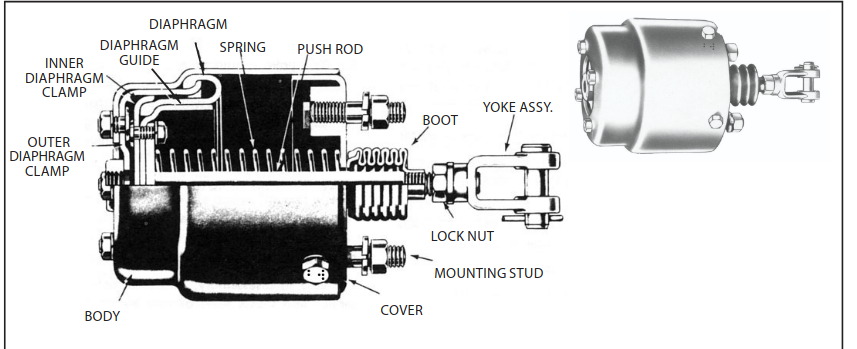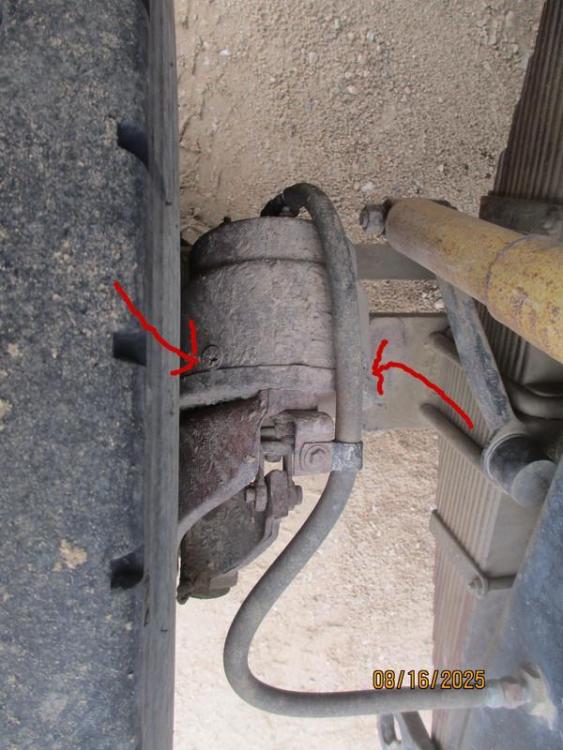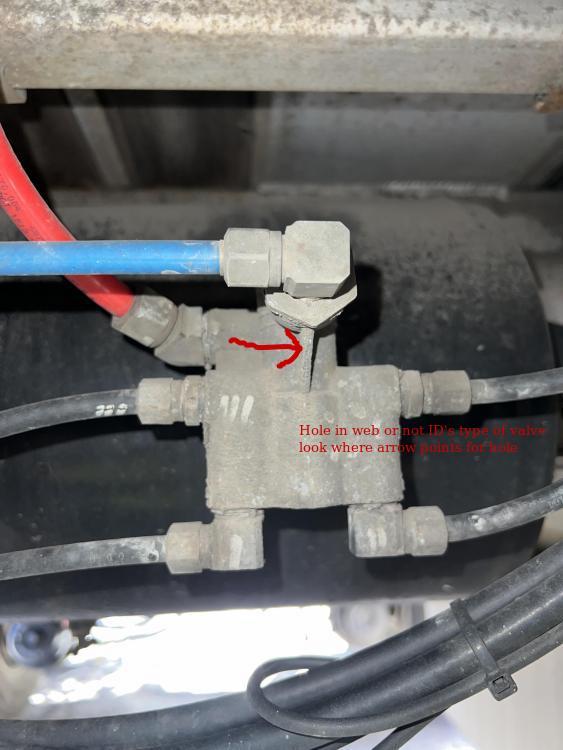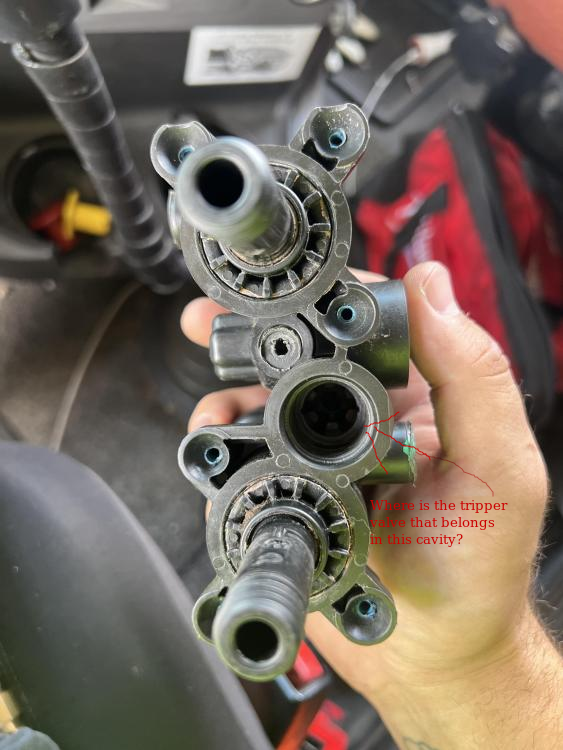
Geoff Weeks
Pedigreed Bulldog-
Posts
2,168 -
Joined
-
Last visited
-
Days Won
7
Content Type
Profiles
Forums
Gallery
Events
Blogs
BMT Wiki
Collections
Store
Everything posted by Geoff Weeks
-
What did you see when you ran the test? With or without the hole in the web?
-
It is not a piston that wears a ridge, If the can is solid and the screws come out, your good to go. There is no wearing contact between the piston and the outside, the bladder is a "rolling lobe" like an air bag on air ride.
-
The "bladder" is about $200 +/- depending on where you get. Toss up between two Type 24's or one "badder" for the can. I would keep the rotochamber, but that is me.
-
-
There is a return spring, just like on a clamp type chamber, but it is weak just to return the piston, not like a spring brake, which provides the braking force.
-
Take the red and blue lines off the spring brake valve. Have someone in the cab press in the red button, you should get a large volume of air out the red line, basically a direct line to the red tractor line, so lots of air. red button will not lock in because it detects a large leak. Re connect the red line and have him charge the trailer. No air should come out the blue line or the fitting on the spring brake valve it was attached too. have the assistant pull the Johnson bar, you should get lots of air out the blue line. If it passes that test, re-connect the blue line (red should already be on) Pull out the red knob. remove any one of the black lines and its fitting from the spring brake valve. Install a 0-150 psi gauge in the port and have the assistant push in the red knob, you should see the pressure on the gauge rapidly rise to system pressure. Then have him pull the red knob out, the pressure should fall to 0 almost at once. Do not have your face under the spring brake valve when preforming these tests, you could get air and debris blasted into you. Test results poor low flow on the red = clogged line Poor-low flow on the blue= clogged line delivery port pressure checks doesn't rise to system pressure or leaks constantly =failure of valve Doesn't exhaust pressure immediately when red knob is pulled, but maintains pressure or pressure falls slowly = failed valve
-
1st picture is the ABS 2nd picture might be it, but is not a SR-5 so not subject to recall. You don't even know if the valve is at fault, could be crap in the lines. Looks like a "Sealco" spring brake valve: https://sealcocvp.com/product/110800/ Again, I advise against replacing stuff "willy nilly" esp when we are talking about stuff as important as brakes. Note: there are two version of this basic valve, one prioritizes the res the other the spring brakes, make sure you get the right one if you do replace it. One will have a drilled hole on a web for ID purposes.
-
On an air tank most often, but don't go half assed running to replace it. I don't know if your trailer even has one, or that it is the problem. I needs proper diagnosing of what is the problem. I just mentioned the SR-4 because I had one that the only symptom was the spring brakes didn't apply (until all the air in the trailer was lost). In looking at spring brake valves, I came across the SR-5 re call.
-
Way too long. There is a re-call out on the Bendix SR-5's mfg between Jan 2014 and March 2016. No idea if it applies to your trailer, or if that is even the problem. You have more work to do, but I strongly recommend a good shop that knows what they are doing and what to look for,
-
I've had SR-4's fail and never set the spring brakes. A restriction in the system could cause a delay. I want clarification on the time frame before for calling just a typo. He states seconds a sentence later when talking about the two ventings, which is correct the "dump" valve doesn't trip until the pressure is way down in the spring brake line. That may take a second or two after the Spring Brake valve functions.
-
This bothers me, it should not take 1-1.5 minutes for the trailer brakes to set. I would be OK if it was 1-1.5 seconds. When the red button is pulled out, what should happen is the air in the line to the Tractor Protection valve back on the frame, should exhaust out the MV-3 exhaust port (in this case the yellow line). The TP should immediately slam shut, closing off both the supply and service lines from the tractor and venting the supply line from the TP all the way to the trailers spring brake valve on the trailer. The spring brake valve should do many things at this point, It should prevent the air from the air tank from escaping back up the supply line, it should detect the lack of air coming from the tractor on the supply line and immediately exhaust the air going to the spring brakes, applying the spring brakes almost at the same time as it lost supply. On newer air ride trailers a valve is used in the air suspension line to close off the supply from the level valve and open the lines to the air bags to drop the trailer down on the stops when the spring brakes apply, so it doesn't rise and fall when being loaded/unloaded. It prevents "dock creep". If yours is taking a minute to react, you have more problems on the trailer.
-
Back when I did my Low-Fow Cummins rebuild, the engine kit (Interstate McBee) out of chassie kit was around $1500 and the re-cored 1500 sq in radiator was $2100! That just doesn't seam like it should be. However I could pull Parley's canyon in the summer with a full load, no problem.
-
Former Boston FD , B85F-1211 project, Mack Brothers....
Geoff Weeks replied to T-Mack1's topic in Fire Apparatus
Automotive alternators and generators both produce power to recharge the vehicles battery. Both have electromagnets, neither have permanent magnets. (Some small engines use permanent magnets as do some motorcycles, but the amount they can produce is limited) Modern car and truck alternators all have rectifiers, but they are not separate, they are located inside the case of the alternator, where they can be cooled by the fan. Generators are somewhat limited in their power output. The field is the stationary coil and the power comes from the rotating (armature). The biggest generator generally fitted was a 50 amp unit, and to make those 50 amps, it had to be turning fairly fast. Leece Neville was the 1st to produce automotive alternators, but at the time the only rectifiers were big metal oxide types that had very limiting characteristics. Still, they can produce more power at lower RPM. They had to have remote mounted rectifiers because they were so large and needed a lot of cooling surface area. In most applications the early alternators weren't worth the trouble. In police, fire and tow trucks that might be working at a scene for hours at a time, lights etc on, they were worth it. So they were retro-fitted or installed when the vehicle was ordered. Once silicon diodes were invented around 1960 (late 50's) then the switch to alternators with internal rectifiers became ubiquitous. Before most fire trucks had 120 volt inverters or generators, you could also tap into the AC output with a transformer and run 120volt lights and universal motors for saws and such. Even after the silicon diode, many mfg of large vehicle alternators kept external AC taps for use with a transformer (Delco DN40 and DN 30) as well as various other. In the late 50's Leece Neville sold a "conversion kit" to convert their early external metal oxide rectifier alternator to internal diodes. I did a write up about installing one on my early Leece Neville. -
In the late 2000's I had my 1942 re-cored, and the core was still an orderable item. When I had my Marmon re-cored a few years later, it was a "custom core", move forward to a few years ago, and my good semi-local radiator shop is gone.
-
This is a far cry from "it came apart when I removed it"!
-
Geeze, that would have been helpful to know! You knowth not what your knowth not! So we can conclude the original was defective, at least in some part. So it was good you replaced it. again a lack of clarity is leading to problems. I am going to walk away, this is obviously way beyond what you can do, and you should either find someone local to come and help you or pay for a shop to work on it.
-
-
we're going from bad to worse here. I think it is time to call in professional help or someone who knows air system to put another set of eyes on the problem. It is likely something simple, crossed lines, something left dis-connected etc, but before you do more, we need better info then you can provide. Not you fault, you just don't have the experience needed. Mecho,Joey Mack or I can't "see" what is happening and how the valves and air system is from this end of a computer screen. We are working blind, and you can see but don't know air systems well enough. Not a good chance of success. Do you know anybody with more experience that can come and help you?
-
With the air lines on the trailer hooked up, push the red in and hold it in for 15-30 sec, it should stay in.
-
Red button will not stay in if the red trailer line is open to air. You need to put a dummy gladhand on to test the tractor. I think, according to what we have read, that it does eventually stay in when hooked to the trailer after holding in long enough to charge the trailer. This is normal, the tractor is not the problem. In all my years on my own equipment I only changed one MV and that was because I couldn't get the gasket to repair the old MV-2 on the truck. They don't go bad that often. I since got a new gasket for the MV-2 and re installed it, kept the gaskets in stock because all 3 of my truck had the same valve (which was why I re-installed, the replacement was a Midland and the rest of the fleet was Bendix MV-2)
-
Ok, truck is fine, problem is trailer is leaking off. Concentrate on the trailer. chock wheels, start truck allow to build pressure push in buttons a fully charge the trailer until the compressor shuts off (dryer vents) then turn off the engine without disturbing the buttons and watch the air gauges for the 3 psi/min max drop. If it is dropping fast it is a big leak and should be easy to find, if it is dropping slow it will take more work to find.
-
Ok, if I understand you correctly, the problem only shows when you are connected to the trailer. Please confirm this is so. If the above is true the trailer is the problem, not the tractor. A trailer that completely bleeds off all stored air pressure so every tank in the trailer is at 0 psi, will require briefly holding in the red button when it is 1st charged until the supply line to the trailer reaches the "autotripper" pressure in the valve. This is normal operation. The valve is supposed to automatically pop out if the line pressure is below 25-40 PSI "why did this just start" you may ask? Well you have a leak in the trailer system that is bleeding off all the pressure. Normally it is common for a trailer to bleed down when parked, esp air ride trailers, but there is a valve that is supposed to cut the air to the air suspension and save the air pressure below about 55 psi for the brakes. So how do you determine if you have a big leak, by the DOT pressure test I wrote about earlier DOT pre trip says this is supposed to be done with the pre trip inspection, or by measureing the time it takes for the compressor to cycle back on (blow off to blow off time). I freely admit that I don't do the DOT pressure check on pre trip but rather assess the condition by the duty cycle of the compressor. They both are a measure of how much pressure leaks off in a given time. The DOT method is the one you may be tested against in a level 1 DOT inspection, my method is just a easy way for me to assess the condition of my air system while driving. So called silent leaks can be hard to find, it takes going over everything with soapy water in a spray bottle, looking for bubbles. Sometimes a piece of hose held to your ear can mask surounding sounds and help narrow in on a leaky valve. Braided covered rubber hose can leak along its length and not make a sound but will bubble the entire length when sprayed with soapy water.
-
These were from page two, It wasn't clear to me or to Mecho that you had disconnected the trailer at that time. We are not mind readers. Your admission that you don't know what the system pressure in an air braked truck is, shows you need some guidance from someone looking over your shoulder until you learn the very basics of air brake systems. Operating pressure and how to check for leaks that can't be heard are very basic skills needed to work on the system. They are also part of the pre-trip portion of the CDL test.
BigMackTrucks.com
BigMackTrucks.com is a support forum for antique, classic and modern Mack Trucks! The forum is owned and maintained by Watt's Truck Center, Inc. an independent, full service Mack dealer. The forums are not affiliated with Mack Trucks, Inc.
Our Vendors and Advertisers
Thank you for your support!








